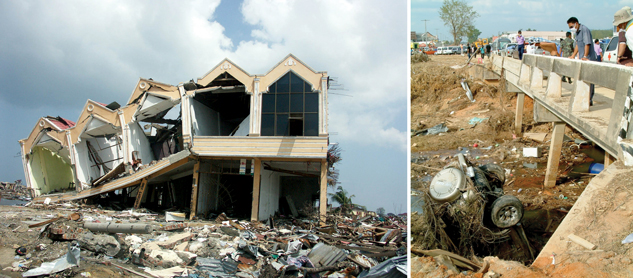Module 8—Mechanical Waves
 Reflect and Connect
Reflect and Connect
When a raindrop strikes the surface of a calm body of water, the energy from the raindrop propagates outwards in all directions in the form of mechanical waves. The speed of these waves can be defined by their wavelength and frequency according to the universal wave equation. Of course, it is not important to determine the speed of the waves radiating outwards from a raindrop’s impact. Larger water waves, however, are of significant interest to those who live near a large body of water. The two photos below show a very small sample of what larger water waves, such as those of tsunami, can do.

left: © A.S. Zain/shutterstock
right: © salamanderman/shutterstock
Consider how the energy of a raindrop and the energy of an earthquake may be related by mechanical waves. Fill a clear glass half full of water, set it on the counter, and bang on the counter once with your fist. What you will see in the glass is similar to what you would see if a drop of water had landed in it. The water medium is disturbed, and the energy of the disturbance propagates outward in the form of a mechanical wave. Hitting the counter harder and harder will produce waves with larger and larger amplitudes. How hard would you have to hit the counter to produce a tsunami like the one that occurred in the Indian Ocean on December 26, 2004?
The water wave directly above the earthquake epicentre was estimated to have an amplitude of about 35 m. For perspective, this is six times higher than the average house. The wave was still 2.6 m high when it reached Mexico, which was 13 000 km away. The inhabitants of the islands and coastal areas of Indonesia and Thailand were simply overwhelmed by the energy of the waves. Use these search terms “NOAA Tsunami Propagation in the Indian Ocean” to find an animation of this tsunami.
Although the waves look small from space, the energy is very large. The amount of mass that shifted in this event changed the shape of Earth, which has shortened the length of a day by 2.68 microseconds. The total energy released by the earthquake is estimated to be about 3.5 x 1018 J. This is equivalent to about 0.8 billion tons of TNT or the quantity of energy consumed in the United States (by more than 350 million people) in 11 days. It was more than a raindrop, but the energy was dissipated in exactly the same way. To learn more about the tsunami of 2004, search the Internet using the words 2004 Indian Ocean earthquake energy.
 Module 8: Lesson 1 Assignment
Module 8: Lesson 1 Assignment
Remember to submit the answer to Discuss to your teacher as part of your Module 8: Lesson 1 Assignment.
 Discuss
Discuss

© din/shutterstock
The Indian Ocean earthquake and subsequent tsunami killed so many people because there was no warning of the impending disaster. It took hours for the first wave to reach many of the shores where widespread death and destruction occurred.
Research the events that occurred in the Indian Ocean on the morning of December 26, 2004, and post an explanation for the following questions:
- How is it possible to predict the arrival of a tsunami in a coastal area?
- Why is it important to identify the epicentre of the event responsible for producing the tsunami?
- How does a tsunami warning system work?
- How can a tsunami warning system fail?
- Was the Indian Ocean tsunami warning system used effectively in the July 2006 Java earthquake? Why or why not?
You can begin by searching the Internet using the terms 2004 Indian Ocean earthquake signs warnings.
When you are finished, put your work in your Physics 20 course folder. Your teacher may require you to submit your explanation for feedback or grades.
 Reflect on the Big Picture
Reflect on the Big Picture
Each of the Reflect on the Big Picture sections in this module will deal with waves and transferring energy. To help reinforce your learning from this lesson, complete at least one of the following reflection activities:
- The amplitude of a tsunami is far greater than the amplitude of waves that surfers ride. Create a work of art that depicts the differences between how people are affected by surf and by a tsunami. Your work of art can be a story, poem, song, painting, drawing, or multimedia presentation.
- Think about your experiences with raindrops and ripples in water. Devise an experiment to determine the speed of waves in water.
- The North Shore of the island of Oahu, Hawaii, is said to have some of the best surfing conditions in the world. Determine the average amplitude of waves that occur on the North Shore. Are the waves that surfers ride transverse waves or longitudinal waves?
Store your completed reflection in your Physics 20 course folder.
 Module 8: Lesson 1 Assignment
Module 8: Lesson 1 Assignment
Remember to submit the Module 8: Lesson 1 Assignment to your teacher.